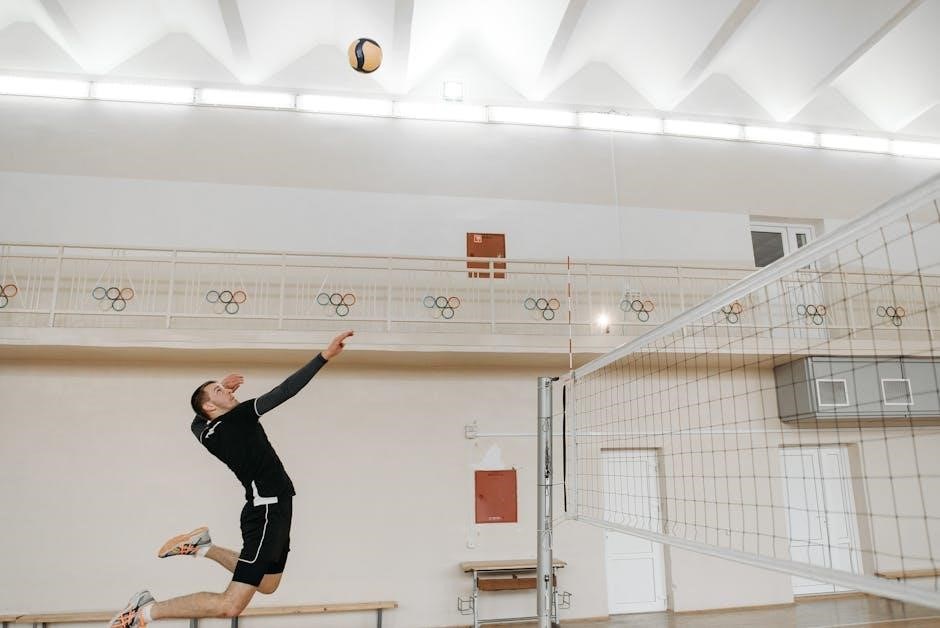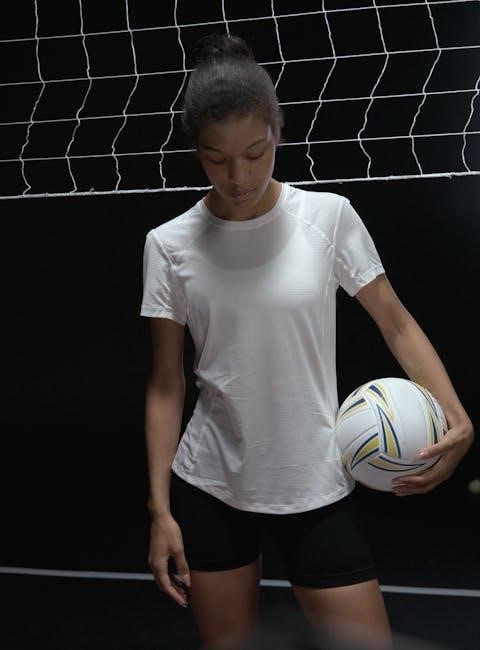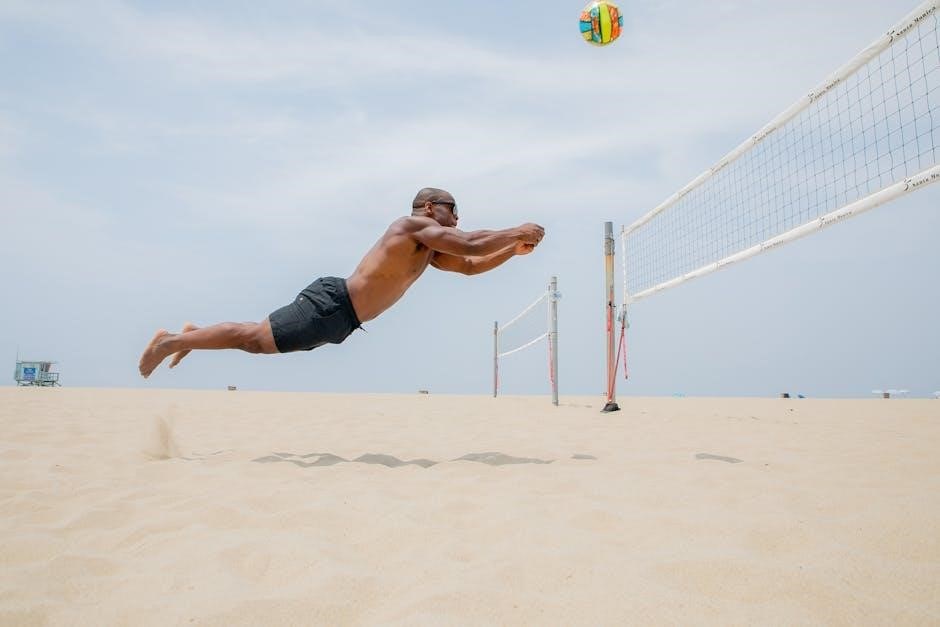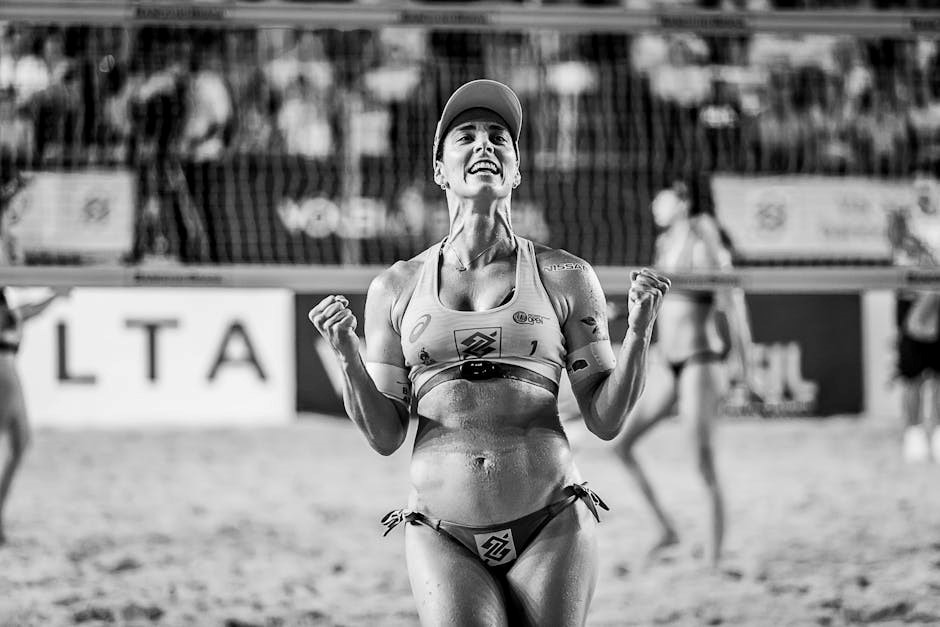Understanding volleyball terminology is essential for players‚ coaches‚ and fans to grasp the game’s strategies and nuances. Volleyball terminology PDF guides offer detailed explanations of key terms‚ from basic actions like ace and bump to advanced tactics‚ ensuring everyone can engage fully with the sport.
Overview of Volleyball Terminology
Volleyball terminology encompasses a wide range of terms that describe actions‚ positions‚ and strategies within the sport. It includes basic actions like ace‚ bump‚ block‚ and spike‚ as well as specific positions such as setter‚ outside hitter‚ and libero. The terminology also covers types of serves‚ like underhand and jump serves‚ and common errors such as ball handling faults and net violations. Understanding these terms provides a foundation for grasping the game’s rules‚ tactics‚ and player roles. Volleyball terminology PDF guides are valuable resources that organize and explain these concepts‚ making them accessible for players‚ coaches‚ and fans alike to enhance their understanding and engagement with the sport.
Importance of Understanding Volleyball Terms
Understanding volleyball terminology is crucial for effective communication among players‚ coaches‚ and referees. It ensures clarity in strategies‚ tactics‚ and rule enforcement‚ enhancing teamwork and performance. Fans also benefit‚ gaining deeper insights into the game’s dynamics and appreciating the skill involved. Volleyball terminology PDF guides simplify learning by organizing terms logically‚ aiding in quick reference and study. Whether improving skills or enjoying matches‚ grasping these terms fosters a richer connection to the sport‚ making it more engaging and accessible for everyone involved. Accurate terminology use is vital for mastering volleyball’s intricate techniques and strategies.

Basic Volleyball Terms
Ace‚ bump‚ block‚ serve‚ set‚ and spike are fundamental actions that form the core of volleyball. Mastering these terms is essential for understanding the game’s basics and strategies effectively.
Ace
An ace in volleyball is a serve that lands directly in the opponent’s court without being touched by any player. It results in an immediate point for the serving team. Aces can be achieved through various serving techniques‚ such as underhand‚ overhand‚ or jump serves. A well-executed ace can disrupt the opponent’s offensive strategy and boost the serving team’s confidence. It is considered one of the most impactful offensive plays in the game‚ demonstrating a player’s skill and precision. Understanding and mastering the art of serving for an ace is crucial for any volleyball team aiming to dominate matches.
Bump

A bump is a fundamental skill in volleyball‚ used to pass the ball using the forearms. It is typically the first contact after a serve or during a rally. The player contacts the ball with their joined forearms‚ keeping elbows straight and arms firm. The bump allows the ball to be controlled and directed to a teammate‚ often to the setter. It is essential for maintaining ball control and initiating offensive plays. Proper technique is vital to ensure accuracy and effectiveness. The bump is a cornerstone skill for all players‚ enabling seamless transitions between defense and offense during the game.
Block
A block is a defensive action in volleyball where a player stops the ball at the net‚ preventing it from crossing into their team’s court. It is often performed by front-row players and can be individual or collective. Timing and positioning are crucial for effective blocking‚ as players must jump and extend their arms to meet the ball. A successful block neutralizes the opponent’s attack and can lead to immediate counterattacks. It is a key defensive strategy and one of the most impactful plays in the game‚ requiring coordination and skill to execute effectively.
Serve
The serve is the initial action in volleyball that puts the ball into play. It involves hitting the ball over the net into the opponent’s court. There are various types of serves‚ including underhand‚ overhand‚ jump‚ and float serves‚ each with unique techniques and purposes. The serve is crucial as it sets the tone for the rally and can create immediate pressure on the opposing team. Proper technique ensures the ball clears the net and lands within the opponent’s court. A successful serve can disrupt the opponent’s offense and provide an early advantage. Understanding and mastering different serving styles is essential for players to enhance their team’s performance and control the game’s flow effectively.
Set
A set is the second contact in volleyball‚ typically executed by the setter‚ to direct the ball to an attacker in a strategic position. It involves using the fingertips to control and place the ball precisely. The setter reads the opponent’s defense and selects the best option for an effective attack. Types of sets include quick sets‚ back sets‚ and front sets‚ each designed to create different scoring opportunities. Proper timing‚ positioning‚ and communication are essential for a successful set. The setter’s ability to deceive the defense while delivering an accurate ball is crucial for the team’s offensive success. Mastering various setting techniques enhances the team’s overall performance and adaptability during a match.

Spike
A spike is a powerful offensive move in volleyball where a player hits the ball sharply downward into the opponent’s court. It is typically executed by front-row attackers‚ such as the outside hitter or opposite hitter‚ and is designed to score a point by making the ball unreachable for the opposing team. The spike is usually the third contact in a play and relies on timing‚ strength‚ and precision. Players often aim for open areas or weaknesses in the opponent’s defense. A well-executed spike can be a decisive play in a match‚ showcasing a player’s skill and athleticism. It is one of the most exciting and impactful actions in volleyball‚ making it a key component of a team’s offensive strategy.
Volleys and Contacts
Volleys and contacts are fundamental concepts in volleyball‚ governing how players interact with the ball. A volley refers to when a player hits the ball in the air without letting it touch their body or the ground‚ requiring precise timing and skill. Contacts denote the number of times a team can touch the ball before it must be returned over the net‚ with a maximum of three touches per side; Understanding these rules ensures fair play and strategic execution‚ as improper volleys or excessive contacts result in penalties. These elements are crucial for maintaining the flow of the game and are thoroughly covered in volleyball terminology PDF guides to help players and officials alike. Proper execution of volleys and adherence to contact rules are essential for competitive success.

Volleyball Positions
Volleyball positions define player roles on the court‚ ensuring strategic team coordination. Each position has unique responsibilities‚ contributing to the team’s overall performance.
Setter
The setter is a crucial player in volleyball‚ primarily responsible for setting the ball to attackers. They must read the defense and deliver precise‚ strategic passes. The setter often runs the team’s offense‚ coordinating plays and controlling the tempo of the game. Effective setters have excellent ball-handling skills and strong court vision‚ allowing them to make quick decisions. They are key communicators‚ directing teammates and executing plays seamlessly. The setter’s role is both technical and leadership-oriented‚ requiring a deep understanding of the game and the ability to adapt to different situations. Their performance significantly impacts the team’s offensive success.
Outside Hitter
The outside hitter is a versatile player who excels in attacking and defensive roles. They typically play on the left side of the court and are known for their powerful spikes and ability to score points. Outside hitters are often the primary attackers‚ utilizing their speed and agility to outmaneuver opponents. They must also contribute to blocking and digging‚ making them well-rounded players. Their strong hitting techniques and court awareness enable them to adapt to various game situations. The outside hitter’s combination of offensive and defensive skills makes them a vital asset to any volleyball team‚ enhancing overall performance and strategy execution.
Middle Blocker
The middle blocker is a key defensive specialist in volleyball‚ primarily responsible for blocking attacks at the net. They play in the center front position and often have the quickest access to the net. Middle blockers must possess strong jumping ability‚ timing‚ and spatial awareness to effectively block opponents’ spikes. Their role also involves reading the opponent’s offense to anticipate attacks and position themselves strategically. In addition to blocking‚ middle blockers may participate in fast attacks‚ making them a dynamic component of both defense and offense. Their effectiveness directly impacts the team’s defensive strength and overall performance in critical game moments.
Libero
The Libero is a specialized defensive player in volleyball‚ introduced to increase excitement and promote longer rallies. They wear distinct colored uniforms to differentiate themselves from other players. The Libero can only play in the back row and is restricted from blocking‚ attacking‚ or serving. Their primary role is to receive serves and participate in defensive actions‚ using effective digging and passing techniques; The Libero’s ability to read the game and make precise movements is crucial for their team’s success. They are often considered the backbone of the team’s defense‚ ensuring smooth transitions from defense to offense with their exceptional skills in ball handling and positioning.
Opposite Hitter
The Opposite Hitter‚ often referred to as the “right-side hitter‚” is a versatile player in volleyball‚ typically positioned opposite the setter. Their primary role is to attack from the right side of the front row‚ utilizing powerful spikes and precise hits to score points. They also contribute defensively by attempting blocks at the net. The Opposite Hitter must possess strong offensive skills‚ as well as the ability to read the opponent’s defense‚ making them a key asset for initiating attacks and creating scoring opportunities. Their coordination with the setter and other hitters is vital for executing effective plays and maintaining offensive momentum throughout the game.

Volleyball Serves
Volleyball serves are the initial actions to put the ball into play‚ with types like underhand‚ overhand‚ and jump serves offering varying degrees of power and deception to challenge opponents.
Underhand Serve
The underhand serve is a fundamental technique where the server contacts the ball with an underhand motion‚ typically below the waist. It is often used to safely put the ball into play‚ especially by younger players or in less competitive settings. The ball is usually served with a gentle toss and struck with the forearm or fist. This serve is less powerful than overhand serves but can be highly accurate. Coaches often emphasize proper footwork and body positioning to ensure control and consistency. The underhand serve is a great way to start a rally without risking a difficult play.
Overhand Serve
The overhand serve is a common and effective way to start a play in volleyball. It involves tossing the ball slightly above the head and striking it with the heel of the hand. This technique allows for more power and accuracy compared to the underhand serve. Players often use different grips and tossing heights to vary the serve. Overhand serves can be flat‚ topspin‚ or float‚ each with its own strategic purpose. Mastering the overhand serve is crucial for players aiming to compete at higher levels‚ as it offers versatility and the ability to pressure opponents. Proper technique and practice are key to executing it effectively.

Jump Serve
The jump serve is an advanced serving technique in volleyball that combines power and precision. It involves tossing the ball slightly above the net and jumping into the air to strike it with the hand. This motion generates significant power‚ making it difficult for opponents to receive. The jump serve often results in aces or weak returns‚ providing a strategic advantage. Players must master timing and body positioning to execute it effectively. The jump serve is commonly used in competitive play to pressure opponents and disrupt their offense. Proper technique and consistent practice are essential to avoid errors and maximize its impact during a match. It’s a key skill for advanced players aiming to dominate the game.
Float Serve
The float serve is a fundamental serving technique in volleyball‚ characterized by its smooth‚ arcing trajectory. It involves tossing the ball and striking it with the palm‚ creating minimal spin‚ which makes the ball appear to “float” in the air. This type of serve is highly effective because its unpredictability can make it difficult for opponents to time their passes accurately. Float serves are often used to target weak receivers or create defensive instability. Players prefer this serve for its simplicity and reliability‚ making it a staple in both beginner and advanced strategies. Mastering the float serve enhances a player’s ability to control the game’s tempo and pressure opponents effectively.
Jump Float Serve
The jump float serve combines elements of both the jump serve and the float serve‚ offering a powerful yet deceptive way to start a play. Performed by jumping into the air and striking the ball with the heel of the hand‚ this serve generates speed and spin‚ making it challenging for opponents to receive. Its unique trajectory often confuses receivers‚ leading to poor passes or errors. Advanced players use the jump float serve to exploit defensive weaknesses and create immediate scoring opportunities. Mastery of this serve requires precise timing and technique‚ making it a valuable asset in competitive play. Coaches often emphasize its importance in high-pressure situations.

Common Volleyball Errors
Ball handling and net violations are frequent mistakes. Lifts and double hits disrupt plays‚ while rotation errors lead to penalties. Understanding these errors is crucial for improving gameplay and team performance effectively.
Ball Handling Error
A ball handling error occurs when a player illegally contacts the ball‚ such as lifting or double-hitting. This often happens during sets or digs‚ disrupting the team’s offense and leading to a point for the opposing team. Officials closely monitor player movements to ensure compliance with rules. Proper technique and practice are essential to minimize these errors. Understanding ball handling errors helps players refine their skills and maintain legal gameplay. Addressing this issue is crucial for team success and fair competition in volleyball.

Net Violation
A net violation occurs when a player interferes with the net during play‚ such as touching it with any part of their body or clothing. This can happen while attacking‚ blocking‚ or attempting a spike. Officials strictly enforce this rule to maintain fair play. Players must avoid reaching over or under the net illegally. Understanding net violations is crucial for competitors to avoid penalties and ensure smooth gameplay. Proper positioning and awareness are key to preventing such errors. Teams that minimize net violations gain a competitive edge‚ fostering a balanced and enjoyable match for all involved.
Lift
A lift is a violation in volleyball where a player illegally holds or throws the ball‚ rather than making a clean pass. This contact resembles a carry‚ with the ball often appearing to linger in the player’s hands. Referees closely monitor such actions to ensure adherence to rules. A lift is distinct from a double hit but similarly disrupts the flow of play. Understanding the difference between a legal pass and a lift is vital for maintaining fair gameplay. Teams must train to avoid lifts‚ as they result in lost points and can shift the game’s momentum in favor of the opposing team. Proper technique and awareness are essential to minimizing this error and ensuring smooth play.
Double Hit
A double hit occurs when a player contacts the ball twice in succession without another player touching it between the hits. This action is prohibited in volleyball‚ as each team is allowed only three contacts per play. A double hit disrupts the flow of the game and results in a point for the opposing team. It often happens during defensive plays or when players are under pressure‚ leading to rushed decisions. Teams must practice precise communication and timing to avoid this error. Understanding the rules surrounding contact is crucial for maintaining fair and competitive gameplay. A double hit can significantly impact the momentum of the match‚ making it essential for players to adhere to proper techniques.
Rotation Error
A rotation error occurs when players fail to maintain the correct rotational order or positioning on the court. This mistake disrupts team strategy and can lead to a loss of point. It often happens due to miscommunication or forgetting the rotation sequence. Teams must adhere to rotational rules to ensure smooth transitions during play. A rotation error can confuse defensive positioning and hinder offensive effectiveness. Coaches emphasize the importance of proper rotations to maintain tactical advantages. Players must stay alert and follow rotational strategies to avoid this common error‚ which can significantly impact the game’s outcome and team performance. Awareness and practice are key to preventing rotation errors.

Volleyball Gameplay Actions
Volleyball gameplay actions include essential skills like block‚ dig‚ and spike‚ which define the flow of the game. These actions require precision‚ timing‚ and teamwork to execute effectively.
A block is a defensive action where players at the net attempt to stop an opponent’s attack by contacting the ball with their hands. It involves timing and positioning to intercept the spiked ball before it lands. A successful block can shift momentum in a game and is considered a powerful defensive tool. Teams often coordinate blocks‚ with multiple players jumping to create a barrier. The block is crucial in high-level play‚ requiring strength‚ agility‚ and strategic teamwork. Proper footwork and hand placement are essential to execute an effective block without committing a net violation.
Dig
A dig is a defensive move where a player contacts the ball to prevent it from hitting the ground‚ typically after an opponent’s attack. This skill is fundamental in extending rallies and giving the offense another chance to score. A successful dig requires excellent reflexes‚ positioning‚ and forearm technique. Liberos and defensive specialists often excel in this role due to their expertise in reading the game and anticipating the opponent’s moves. Proper body positioning and arm placement are critical to control the ball effectively. A dig not only showcases individual skill but also demonstrates strong teamwork and determination to keep the play alive.
A spike is an offensive play where a player forcefully hits the ball downwards into the opponent’s court‚ aiming to score a point. It is one of the most dynamic and critical skills in volleyball. Spikers‚ often the outside hitters or opposite hitters‚ approach the net and jump high to strike the ball with precision and power. The spike can be preceded by a set from the setter‚ allowing the attacker to time their jump and contact. Effective spikes combine strength‚ timing‚ and strategy‚ making them a key component of a team’s offensive strategy and a thrilling aspect of the game for spectators. Proper technique ensures both power and control‚ maximizing the chance of scoring.
Bump Pass
The bump pass is a fundamental defensive skill in volleyball‚ used to control the ball when it’s hit sharply or at a low angle. Executed with the forearms‚ the player stands with knees slightly bent and arms extended‚ making contact with the ball using the inside of their forearms. The elbows are kept close together‚ and the wrists are firm to ensure a controlled pass. This technique is essential for libero players and defensive specialists‚ as it allows the team to maintain possession and transition into an offensive play. Proper body positioning and timing are crucial for effective bump passing‚ making it a cornerstone of a strong defense. Mastering the bump pass enhances overall team performance and coordination during matches.
A set is a tactical movement where the setter directs the ball to an attacker‚ creating a scoring opportunity. It involves precise timing and coordination between the setter and hitters. The setter typically positions themselves to receive the second contact‚ using their hands to guide the ball to the optimal hitting position. There are various types of sets‚ including quick sets and back-row sets‚ each designed to exploit defensive weaknesses. Proper footwork‚ hand positioning‚ and misdirection are key to executing effective sets. This play is central to a team’s offensive strategy‚ requiring skill and teamwork to deceive opponents and create powerful attacks. Mastery of the set is vital for any volleyball team aiming to dominate matches.
Attack
An attack in volleyball refers to the action of hitting the ball with the intention of making it land on the opponent’s side of the court. It is a crucial offensive maneuver‚ often following a set from the setter. Players use various techniques such as spikes‚ tips‚ and rolls to execute an attack. A successful attack requires precise timing‚ strength‚ and strategy to outmaneuver the opposing team’s blockers and defenders. Effective communication and coordination between attackers and setters are key to maximizing scoring opportunities. Attacks are a fundamental aspect of volleyball‚ driving the team’s offensive efforts and creating dynamic gameplay. Mastery of attacking skills is essential for any aspiring player to excel in the sport.
